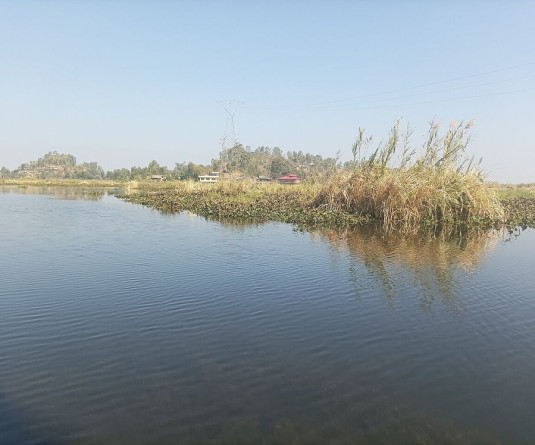
T.N. Mannen IAS (Rtd)
The Inner Line, Regulation derived its authority from the Bengal Eastern Frontier Regulation 1873. This is a unique regulatory device by which the Governor General-in-Council in 1873 empowered the Lt. Governor to notify a marked boundary line to be called the ‘Inner line”. Beyond this line the British citizens and outsiders were restricted to cross without permission from the District Administration. On successful establishment of the 1st Tea cultivation at Sadiya area by an Englishman Bruca and thereafter the Tea industry flourished. Many Britishers including serving district administrators and Police officers resigned from lucrative government service to take up Tea plantation. That had put a lot of pressure on searching for suitable land especially in upper Assam. Establishment of tea cultivation beyond the declared tradition Ahom-Naga Boundary called “Naga Bund”Dodhar Ali and Ladigarah Road” which was accepted by the British Government of Assam as the southern limit of revenue jurisdiction and the ultimate boundary between Sibsagar District of Assam and the Nagas tribes had created new problem. In pursuance of the Non-Interference policy towards Naga tribes, they normally refrained from interferences in any affairs beyond this boundary limit. But with the mad expansion of the Tea cultivation beyond this traditional line and discovery of Coal and Oil along the foot hills areas of Kongan, Wakching and adjacent places, it was felt the necessity of shifting the dividing line of control by the British government of Assam though the government had initially accepted this line as the final boundary between Sibsagar district and Naga territory. But subsequently, there were 6(six) Notifications changing the Inner Line jurisdiction limit and altering the boundary line along the Sibsagar –Naga territory and Naga Hills later.
1. No. 1486 Dtd. Simla The 21st June 1876.
This is the first Inner Line notification indicating the Sibsagar district and Naga Hills administrative boundary. This line followed the Southern Revenue Survey Boundary from its eastern limit on Disang River to its western limit, a point on the Doyang River. This line followed the traditional Ahom Naga boundary called “Naga bund” and Ladigarah Road which the provincial government had accepted as the boundary between Sibsagar-Naga territories. According to this line, 5 (five) Reserved Forests, namely (a) Doyang ¾ R/F(b) Desoi valley RF (c) Desoi R/F (d)Tiru Hills R/F and (e) GelekiR/F, areas were still shown within the Naga Hills(it is clearly shown in a relevant map)
2. No 330 EP. Dtd 24th Feb 1882.
This Notification, issued in modification of the earlier one had further pushed the line towards the Foothills encroaching deeper into the Naga territory from the point of Desoi River along the hills till Jhanji(Milak) river. It had further taken away valuable Naga virgin forest land for Tea Garden development and for extraction of forest wealth. The local officers were however warned not to rush needlessly which might create suspicious on the Ao Naga Landowners. This newly encroached forest area was subsequently converted into Desoi R/F and transferred out to Sibsagar District without clearly specifying the boundary of the R/F. Even the Naga Hills district officers had objected to this conversion and strong protest even from local people. The boundary of this Desoi R/F was finally issued only in 1892.
3. No 1437(P) Dtd 11th April 1901.
This notification had modified the earlier one issued on 24/02/1882. Mokokchung Sub-Division was created in the year 1890 and out of its area a tract of land approximately 67 Sq. miles on the northern fringes was taken out and incorporated in Sibsagar district with an observation by the government of Assam that “the transfer would be in the interest of the tea industry as well as the administration”. By then the Assam-Bengal Railway had developed and this tract of land which was considered very suitable for “tea industry” and extracting timber and other forest wealth. Thus, this new Inner Line further pushed deeper into the Naga territories towards the Hills. Out of this tract, two new reserved forests were created (a) Geleki (Dtd 22/02/1918) and (b) Tiru Hills R/F (22/02/1918).
However some rights were granted to the Nagas inside this R/F
(i)Geliki Reserve Forest:-
(a)Kansingia Naga Path (b)Deopani Naga Path (c)Naga path along the Jhanji(Milak)river.
(ii)Tiru Reserve Forest:-
(a)Molongyimsen- Amguri Naga Path (b) Yachang-Rangkam Naga Path (c)Lirmen-Naganijan Naga Path. (d) The privilege of cutting Tokupat and collection of betel leaves.
There are record to show that Assam tea company under Geleki division were making payment annually to (a) Molung Village Rs 20 and Kansing(Kangtsung) Rs 15 for use of bamboo in Geleki Division (Home 1889 Deptt proceding January No 125-133)
4. No 5544 P. Dtd 11th 1902.
With the formation of Mokokchung Sub-Division on 28/2/1890, it was felt necessary to abolish Inner Line restriction imposed by the earlier notification dated 11/4/1901 in a portion of Sibsagar district between Dikhu-Doyang rivers. Thus with the sanction of Govt. of India, government of Assam through this notification abolished this portion between Dikhu-to Doyang River
5. No 67 P Dtd 1/2/1910.
This notification was issued modifying the earlier ones dated 11/04/1901 and 11/12/1902.
After the abolition of “Inner Line” between Doyang to Dikhu River, there were petition to push the line towards the hills east of Dikhu further south. This was to bring Kongan Naga(Konyaks) village outside the Inner Line to enable an individual R.A. Mohanta petitioning government to allow him to take possession of land gifted by Kongan Naga village for Coal mining in the land. There was another request on behalf of Assam-Bengal Railway Company for permission to prospect coal near Kongan land south of Naganimora where Mr. Mohanta was interested for coal mining. The Chief Commissioner Assam had no objection to grant permission to Assam-Bengal Railway Company but not to the individual. When this was referred to Naga Hill Deputy Commissioner he recommended for extension of “Inner Line” towards Wakching, Kongan before permission were granted. But in the meantime Assam-Bengal Railway Company lost interest and the Inner Line east of Dikhu south of Naganimora was spared but the Inner Line in the north towards Arunachal Pradesh a portion of Tirap Frontier area was modified.
6. No 76.P. Dtd 1/2/1910.
In 1906 the Assam Company had expressed its renewed interest in prospecting minerals like Coal and oils and other allied products in the area south of the existing Inner Line. With the permission of the Government of India the company negotiated with the Nagas for mineral rights in the coal deposit tracts of Kongan and Wakching. They arrived at an agreement for an exclusive right for prospecting and mining of minerals. A joint visit was conducted consist of Deputy Commissioner of Sibsagar and Naga Hills and General Manager of Assam Company and the SDO Civil of Mokokchung to the area. In this visit the coal bearing tract was found outside the Inner Line and within the jurisdiction of Kongan village. Thus, with the recommendation of DC Mokokchung Kongan and Wakching area were added to Mokokchung Sub-Division of Naga Hills District rather than to Sibsagar district. He also recommended that, like in the case of Namsang for leasing out to Tea cultivation, subsidy to Kongan villagers from the company also be routed through the District Adm. After the second tour of the area by the SDO Mokokchung, another 14(fourteen) more villages between Yangnyu (Dikhu) and Saffria (Wapnu) were added into Naga Hills District. As conveyed by Foreign Deptt letter No 1730 E.B Dtd 26th Oct. 1909, the entire coal bearing areas of Kongam, south of Sibsagar Inner Line between Dikhu and Tawkok river was annexed to the Naga Hills district (Mokokchung Sub-Div.). Further, the Inner Line between the Dikhu and the Tawkok rivers was abolished.
Naga Hills District Inner Line.
No.7014 Dtd 15th Nov. 1928:- This notifacation was the 1st Naga Hills District Inner Line. The 6 (six) notifications issued earlier were all related to the Lines demarcating between Sibsagar district and the adjacent Naga territory (Naga Hills) inhabited by the Konyak, Phom, Ao, Lotha groups between presently Mon district to Wokha-Dimapur district.
With the abolishment of Inner Line along the Sibsagar district from Doyang River to Tawkok River, The British Government had realized that there would be nothing to prevent people from entering the “unadministered” areas through the gaps area not covered by any Line between Sibsagar and Naga Hill border. Also there would be no legal barrier to cross Naga Hills district to enter the “Un-administered territories” to the east of that district. The Assam government observed that “allowing free access to this territory would be fraught with grave danger both to the intruders and to the peace of the country”. Re-notification of an inner Line empowering the DC with legal authority to control free access to the Naga Hills and to the unadministered areas was considered essential by the British officials. While doing so the Assam government had not favored the restoration of old line along the boundary between Sibsagar and Naga Hills District. It was felt that free access could be safely permitted along its western borders without risk but in some area free access could not be considered on grounds of safety to the visitors/intruders. On consideration of all those factors, a new “Inner Line” covering the entire Naga Hills district bordering with the neighboring districts of Assam was drawn up through this notification. By this, again the line was pushed beyond the district boundary to allow free access to parts of the Naga Hills district Western borders without any risk keeping in view of the need to keep, such as, the oil company established at Nichuguard (Chumekedima) and colliery at Borjan {Kongan) outside the Inner Line.
From all those actions of the British Ruled government in Assam starting from 1873 onward till India’s independence; contrary to the popular belief that the “Inner Line” was drawn up to protect the welfare of the indigenous Nagas; the Lines were actually used effectively to safeguard the Eco-political interest of the British Rulers in the region, hugely depriving the legitimate right of the helpless, innocent Nagas. The very fact that the Inner Line was shifted 6(six) time along Sibsagar –Naga Hills border over the years every time pushing deeper encroaching into the Naga territory clearly demonstrated their selfish intention to usurp large chunk of fertile areas deceptively transferring out of Naga Hills after converting first into Reserve Forests without the knowledge of the local Nagas. They were mostly done to accommodate Tea garden expansion and to exploit minerals like Coal and Oil and forest wealth available in that Virgin Naga owned Forests. It is thus, clear that the inner line regulation was conveniently used by the British to peacefully take away the land and wealth out of the local Nagas.
The present “Inner Line’ along the Nagaland –Assam Border may not be coterminous with the claims as final boundary by the Nagas, but it is to be noted that, the Inner line is no proof for the sovereign power over the territory. As stated in the Record,” Inner Line is defined merely for purpose of administration. It does not decide the Sovereignty of territory beyond’ (A Mackenzie the North East Frontier of Assam.p89)
Do this provision is required now?
The same Inner Line regulatory provision can be an equally effective tool with the state government of Nagaland and the people. It can be advantageously used for containing the continuous inflow of encroachers like in the present incident Saring village areas And if the land belonging to the Nagas irrespective of where it is located are allowed to encroach by the outsiders, nobody else are to blame for it but the Nagas. People from the other side are wiser to come pushing and expelling the Nagas away from their land taking advantage of unorganized and casual approach from Nagaland side. At the governmental level the management of the Border Affairs needs revamping to make it more prompt and efficient to deal with any eventuality along the border. Border Magistrate be authorized to regulate the entry of outsiders into NAGALAND more strictly by issuing temporary or semi- permanent Inner Line permit as the case may be, by realizing an uniform fee which can be a good source of revenue for the state. Unauthorized intruders can be arrested and fine.
A Border Vigilante Committee
The pack up group or Border Vigilante Group to the Border Magistrate should be organized which should include police contingent, village guard (which is already decided by the government for implementation) and border area villages’ council and respective tribal organizations. Nagas should realize that occasional outburst emotionally and cooling off completely only strengthens the opponent. External vigilance should be our price of protecting the borders areas. Population is alarmingly increasing at the exponential rate but our border areas are still continuously sinking due to constant encroachment from our neighbors. Border villages Council members and other NGOs must actively organize the border villages’ vigilante committee to correct, assist and support government afford to guard the border areas. After all eternal vigilant is the price of protection.
Road along the Border.
The biggest problem is accessibility to the border villages and non- availability the main Foot Hill Road through the Nagaland border belt which is most vital for Socio-Eco-Political reasons. Proper feeder roads must connect all border villages from this main Foot-Hills-Road. Obviously, lots of avoidable embarrassing harassment mitted out to the innocent travelers by Assam police and NGOs while passing through Assam are no exaggeration apart from demands of gate tax, police dhana tax, bokshis, chai bellau and such demands with ingenuity to say the lest. No one feel comfortable while travelling in Assam. Besides, the economic strangulation and exploitation is another story which the Nagas silently bear all these years. In the name of 50 year of statehood let this foothill road is taken up in its honor with the collaborative effort of government and the people. Government can float a public loan scheme to be repaid on a staggering manner by government.
The demand made for priority construction of this Road is most reasonable which can be possible through such a joint collaborative manner by government and people initiative This most vital link is being neglected for too long and no excuse will justify further delay but at the same time it should not be turn into an arena for passing the buck or rationalizing the neglect and failures.
Readers may please note that, the contents of the articles published on this page do not reflect the outlook of this paper nor of the Editor in any form.





